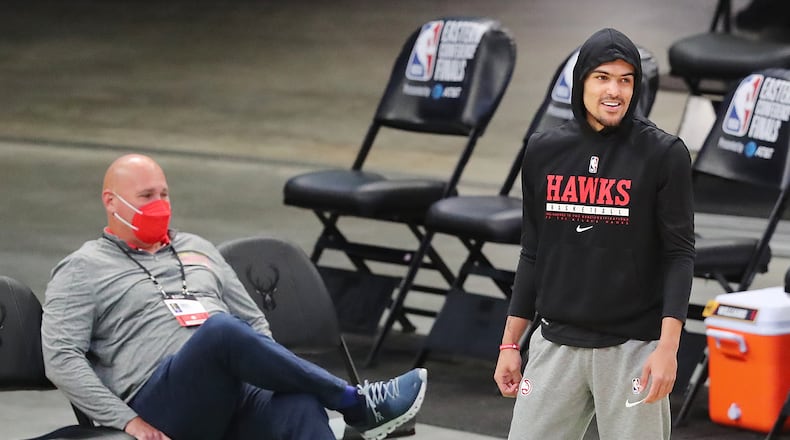The Hawks don’t own a top-10 pick for the first time in Travis Schlenk’s five drafts as general manager. That doesn’t mean pick No. 20 in Thursday’s draft is less important than the others. In one way, the fact that Schlenk hit so often on his previous picks puts some pressure on him not to miss on this one.
Soon it will be time to pay up for the players Schlenk drafted who became good NBA players. It starts next week, when John Collins is free to sign a contract with another team that the Hawks can match. They’ll go through the same thing with Trae Young next summer unless they sign him to a contract extension before then. In 2023, De’Andre Hunter and Cam Reddish can test the market as restricted free agents.
If the Hawks keep those players long-term, they’ll get raises that eat more salary-cap space. That will make it harder for the Hawks to sign or trade for high-priced veterans. The draft is the best way to add good players for relatively cheap because their salaries are suppressed by the rookie scale for up to four years. If Schlenk gets another prospect from this draft who becomes a good NBA player, it would alleviate some cap pressure he tries to build a championship roster.
The Hawks don’t necessarily need their rookies to contribute next season. If they retain Collins, they’ll have the option to bring back eight of the top nine players in minutes played during the Eastern Conference finals. The exception is backup point guard Lou Williams, who is a free agent, but the Hawks have the cap space to fill that slot with a good veteran.
The circumstances mean the Hawks really can draft the best available player, which all teams say they will do without necessarily meaning it. The Hawks could use a dynamic scoring guard to play alongside Young. Maybe they plan for Collins’ potential departure, next summer if not this one, by drafting a big man. The Hawks could select a point guard to become Young’s future backup.
The Hawks can’t expect to draft a future star at No. 20. It’s 50/50 to get a solid bench player when picking that late. The Hawks would (theoretically) increase their chances of drafting a player with more potential by trading up. They have the assets do it, in addition to picks No. 20 and 48 in this draft.
Several reports indicated that the Hawks are taking calls on Reddish. He once was the top player in his class, but after one disappointing season at Duke, Reddish slipped to No. 10 in the 2019 draft. Reddish has yet to find his NBA footing, in large part because he hasn’t developed a consistent jump shot.
But Reddish will be only 22 years old next season, and injuries have held him back. He has two more seasons on his rookie deal before he reaches free agency. Reddish showed enough in his few playoff minutes that another team might be willing to pay him $10.6 million over the next two seasons to see if he can stay healthy and fulfill his potential. Of course, those also are reasons for the Hawks to keep him.
Credit: Curtis Compton / Curtis.Compton@
Credit: Curtis Compton / Curtis.Compton@
Kris Dunn also might have some trade value. Schlenk took a chance by signing Dunn last summer despite his injury history. Injures derailed Dunn again: He played only four games this season and 33 minutes in the playoffs. When healthy, Dunn is a great wing defender — they are always in demand — and his $5 million salary for next season is reasonable.
If Schlenk keeps the 20th pick, his track record suggests he has a good chance of drafting the right guy. Schlenk has drafted or traded for six prospects in the first round. Omari Spellman, the No. 30 pick in 2018, was the only clear miss.
Schlenk hit a home run in 2018 with Trae Young (acquired with the No. 3 overall pick). He got it right with Collins (No. 19, 2017) and Kevin Huerter (No. 19, 2018). Hunter, acquired by Schlenk as the No. 4 pick via trade in the 2019, is a keeper. The jury is out on Onyeka Okongwu (No. 6, 2010), but something seemed to click for the big man in the playoffs.
Young, Collins, Hunter, Reddish and Huerter formed a core of talent for the Hawks. Schlenk added to that base by trading for Clint Capela at the 2020 deadline. He continued building by signing three key free agents in November: Bogdan Bogdanovic, Danilo Gallinari and Rajon Rondo. Schlenk swapped Rondo for Williams in March to complete what became the roster that went to the East finals with coach Nate McMillan.
The Hawks can easily keep that group together for 2021-22. They can sign Collins to a big contract this summer and add other veteran free agents without exceeding the luxury-tax threshold. Things get trickier in the summer of 2022. The Hawks can release Gallinari with little cap pain then, but to keep the rest of their group intact, they’d owe big raises to Young and Collins.
That’s how it goes for NBA teams that successfully rebuild via high draft picks. Schlenk has done it better than the 76ers, who were eliminated by the Hawks in the East semifinals. The Hawks are going to have to start paying their top young players over the next two summers and tighten their salary cap. Schlenk can make that process less daunting by drafting a prospect Thursday who becomes a good player with a relatively modest salary.
About the Author
The Latest
Featured



